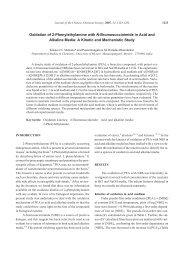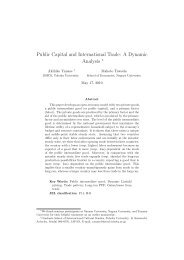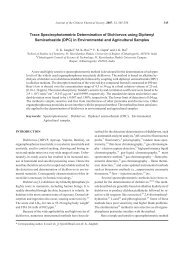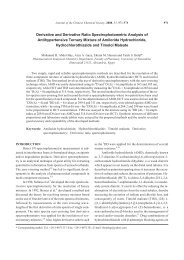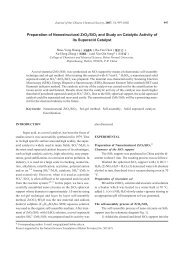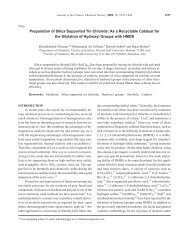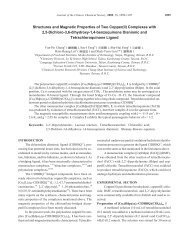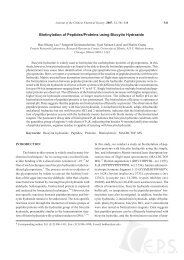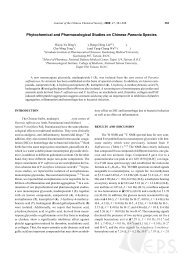Facile, Regioselective and Green Synthesis of Ortho-nitrophenoles ...
Facile, Regioselective and Green Synthesis of Ortho-nitrophenoles ...
Facile, Regioselective and Green Synthesis of Ortho-nitrophenoles ...
You also want an ePaper? Increase the reach of your titles
YUMPU automatically turns print PDFs into web optimized ePapers that Google loves.
<strong>Facile</strong>, <strong>Regioselective</strong> <strong>and</strong> <strong>Green</strong> <strong>Synthesis</strong> <strong>of</strong> <strong>Ortho</strong>-<strong>nitrophenoles</strong> Using<br />
NaNO2, KHSO4<br />
Majid M. Heravi,* Hossein A. Oskooie <strong>and</strong> Bita Baghernejad<br />
Department <strong>of</strong> Chemistry, School <strong>of</strong> Science, Azzahra University, Vanak, Tehran, Iran<br />
Certain phenols <strong>and</strong> naphtols were nitrated regioselectively with NaNO2 in the presence <strong>of</strong> KHSO4 at<br />
50 C in high yields.<br />
Keywords: Nitration; Phenols; Sodium nitrites; KHSO4.<br />
INTRODUCTION<br />
Nitration <strong>of</strong> phenols using the traditional procedure<br />
<strong>of</strong> nitric acid in sulfuric acid, generally gives complex mixtures<br />
containing o <strong>and</strong> p-nitro phenols, dinitrated phenols,<br />
along with inextractable tars <strong>of</strong> phenolic oxidation products.<br />
1 The distribution <strong>of</strong> the isomer ratio in electrophilic<br />
substitution <strong>of</strong> phenols continues to challenge organic<br />
chemists. Consequently, alternative nitration procedures<br />
have been sought to fulfill, clean <strong>and</strong> regioselect nitration<br />
<strong>of</strong> phenols. In 1995 Lazslo et al. demonstrated that phenol<br />
can be nitrated with a reagent called clay-cop (cupric nitrate<br />
supported onto montmorillonite) in 92% yield with an<br />
o/p ratio <strong>of</strong> 13.3. 2 Nitration <strong>of</strong> phenols as a special case has<br />
been studied using various reagents in different conditions.<br />
3 In this communication, we wish to reveal our results<br />
for the selective, facile <strong>and</strong> green nitration <strong>of</strong> phenols by a<br />
mixture <strong>of</strong> NaNO2, KHSO4.<br />
Our goal in undertaking this line <strong>of</strong> work was threefold,<br />
a) to overcome the limitations <strong>and</strong> drawbacks <strong>of</strong> the<br />
reported methods such as: tedious work up, 4-6 strongly<br />
acidic media, 7 oxidation ability <strong>of</strong> the reagent <strong>and</strong> safety<br />
problems (storage, h<strong>and</strong>ling); 8,9 b) to reach a high yielding<br />
one-pot synthesis <strong>of</strong> mono nitro phenol using a combination<br />
<strong>of</strong> reagent <strong>and</strong> c) to consider the rules <strong>of</strong> green chemistry<br />
to implement nitration in eco-friendly conditions.<br />
RESULTS AND DISCUSSION<br />
Journal <strong>of</strong> the Chinese Chemical Society, 2007, 54, 767-770 767<br />
<strong>Green</strong> chemistry is one <strong>of</strong> the main concerns <strong>and</strong> top-<br />
* Corresponding author. Fax: 00982188047861; E-mail: mmh1331@yahoo.com<br />
ics in our laboratory. 10 Nitrites are widely recognized as<br />
safe environmental compounds. Nitrites are a relevant<br />
source <strong>of</strong> OH · in the atmosphere, both in the gas phase via<br />
photolysis <strong>of</strong> gaseous HNO2 <strong>and</strong> atmospheric hydrometeors<br />
by photolysis <strong>of</strong> NO2 - . 11 Recently, in an unrelated<br />
study, phenols have been nitrated with a combination <strong>of</strong> silica<br />
sulfuric acid, NaNO2 <strong>and</strong> wet SiO2. 12 In this paper, it<br />
has been reported that without wet SiO2, the reaction times<br />
are very long, taking several days to complete. In this paper<br />
a mechanism for using nitration, sodium nitrite has proposed.<br />
12 However in the mechanism, the role <strong>of</strong> wet SiO2<br />
has been overlooked. As far as green chemistry is concerned,<br />
sulfuric acid in any form is notorious, <strong>and</strong> its safe<br />
disposal is one <strong>of</strong> the problems <strong>and</strong> concerns <strong>of</strong> chemical<br />
industries <strong>and</strong> therefore its replacement with safer reagents<br />
is desirable. As mentioned before, NaNO2 as an eco-friendly<br />
reagent has been used along with silica sulfuric acid <strong>and</strong><br />
wet SiO2 for nitration <strong>of</strong> phenols. 12 We have recently used<br />
KHSO4 as a safe <strong>and</strong> green reagent in the synthesis <strong>of</strong> 1,1diacetales<br />
13a <strong>and</strong> facile synthesis <strong>of</strong> quinoxallines. 13b Armed<br />
with these experiences, it occurred to us that the replacement<br />
<strong>of</strong> silica-sulfuric acid <strong>and</strong> wet SiO2 with KHSO4 as a<br />
safe counterpart <strong>of</strong> H2SO4 might result in a more efficient,<br />
selective <strong>and</strong> high yielding nitration with a more reasonable<br />
mechanism for generation <strong>of</strong> NO2 + . Thus we have<br />
treated a variety <strong>of</strong> phenols <strong>and</strong> substituted phenols having<br />
at least one unsubstituted ortho position with NaNO2/<br />
KHSO4 as shown in Scheme II <strong>and</strong> Table 1, <strong>and</strong> obtained<br />
o-nitro phenols in all cases.<br />
The plausible mechanism is given in Scheme I. The<br />
reaction <strong>of</strong> sodium nitrate <strong>and</strong> KHSO4 gives HNO2. Itis
768 J. Chin. Chem. Soc., Vol. 54, No. 3, 2007 Heravi et al.<br />
Scheme I Scheme III<br />
Scheme II<br />
well known that nitrous acid decomposes to nitric acid, particularly<br />
when warmed. 14 HNO3 <strong>and</strong> KHSO4 provide nitronium<br />
ions for the nitration.<br />
The percentages <strong>of</strong> products were obtained by GC/<br />
MS analysis. The alternative mechanism, involving the<br />
generation <strong>of</strong> nitrosonium ion NO + <strong>and</strong> nitrosation followed<br />
by oxidation to obtain the nitro compound, can be<br />
ruled out with this fact that via this mechanism the major<br />
product 15 should be p-nitro phenol which is contrary to our<br />
results.<br />
Among the solvents used such as CH2Cl2 <strong>and</strong> CH3CN,<br />
the latter gave the best yields <strong>of</strong> the o-nitro phenols at 50<br />
C. The absence <strong>of</strong> dinitro-phenols as well as hydroxylation<br />
<strong>and</strong> coupling products was ascertained by GC/MS<br />
Table 1. Selective <strong>and</strong> eco-friendly nitration <strong>of</strong> phenols <strong>and</strong> naphtol<br />
Entry Substrate Products Time (h) Yields<br />
1 phenol<br />
O-nitro phenol 63<br />
p-nitro phenol 7 12<br />
dinitro phenol 06<br />
2 4-nitro phenol 2,4-dinitro phenol 5 92<br />
3 4-bromo phenol 2-nitro4-bromo phenol 5 92<br />
4 4-methoxy phenol 2-nitro4-methoxy phenol 4 94<br />
5 2-naphtol 1-nitro2-naphtol 5 94<br />
Table 2. Nitration <strong>of</strong> phenol with different methods<br />
Entry Reagent o-nitro phenol (%) p-nitro phenol (%)<br />
1 NaNO2/KHSO4 62 12<br />
2 Fe(NO3) 3.9H2O 16<br />
3 Mn(NO3)3. 2H2O<br />
50 50<br />
16<br />
60 40<br />
4 Cu(NO3) 2.3H2O 16<br />
40 60<br />
5 HNO3/Microemulsion 4<br />
6 ZrO(NO3) 2.XH2O 50 50<br />
3a<br />
40 60<br />
7 NaNO3/Mg(HSO4)2 17<br />
36 26<br />
8 NaNO2/Silica sulfuric acid 18<br />
30 20<br />
9 HNO3/Sulfated titania 19<br />
68.6 2.3
Advent in Organic Methodology J. Chin. Chem. Soc., Vol. 54, No. 3, 2007 769<br />
analyses <strong>of</strong> the crude reaction mixtures. The scope <strong>of</strong> this<br />
nitration was widened by nitration <strong>of</strong> naphtols to give<br />
mono-nitrated compounds in high yields (Table 1).<br />
The superior regioselectivity <strong>of</strong> our method is clear<br />
<strong>and</strong> can be justified by comparison <strong>of</strong> percentages <strong>of</strong> ortho<br />
isomers with previously reported protocols (Table 2).<br />
In conclusion, a regioselective ortho nitration <strong>of</strong> various<br />
phenols <strong>and</strong> naphtols using green, available, inexpensive<br />
<strong>and</strong> easy to h<strong>and</strong>le NaNO2/KHSO4 reagent has been<br />
reported. We believe this protocol is an important tool in organic<br />
chemistry.<br />
EXPERIMENTAL<br />
Chemicals were purchased from the Fluka, Merck<br />
<strong>and</strong> Aldrich chemical companies. Melting points were<br />
measured with a Bamstead Electrothermal 9200 apparatus<br />
<strong>and</strong> are uncorrected. GC/MS spectra were recorded on an<br />
Agilent Technologies 6890 network GC system <strong>and</strong> an<br />
Agilent 5973 network Mass selective detector. Thin layer<br />
chromatography (TLC) on commercial aluminum-backed<br />
plates <strong>of</strong> silica gel, 60 F254 was used to monitor the progress<br />
<strong>of</strong> reactions. Yields refer to isolated pure products.<br />
Products were identified by GC/MS <strong>and</strong> the data were compared<br />
to those <strong>of</strong> the authentic samples purchased from<br />
commercial sources.<br />
Nitration <strong>of</strong> phenols with NaNO2/KHSO4. Typical<br />
procedure<br />
4-Bromo phenol (0.14 g, 1 mmol), NaNO2 (0.1 g, 1.5<br />
mmol) <strong>and</strong> KHSO4 (0.27 g, 2 mmol) in acetonitril was<br />
stirred at 50 C. After the completion <strong>of</strong> reaction, the reaction<br />
mixture was filtered (the progress <strong>of</strong> the reaction was<br />
monitored by TLC). The residue was washed with acetonitril<br />
(2 5 mL). Anhydrous Na2SO4 (5 g) was added to the<br />
filtrate. The mixture was filtered. The solvent was removed<br />
by distillation using a water bath (35-40 C). The obtained<br />
crude was pure enough (checked by tlc). For further purification,<br />
this crude was passed through a small pad <strong>of</strong> silica<br />
gel using ethyl acetate/pet ether 1:3 to obtain the pure product.<br />
Yield 0.2 g, (92%), mp 92 C.<br />
Received July 5, 2006.<br />
REFERENCES<br />
1. Zeegers, P. J. J. Chem. Educ. 1993, 70, 1036.<br />
2. Gigante, B.; Prazeres, A. O.; Marcelo-Curto, M. J.; Corneles,<br />
A.; Laszlo, P. J. Org. Chem. 1995, 60, 3445.<br />
3. (a) Selvam, J. J. P.; Suresh, V.; Rajesh, K.; Reddy, S. R.;<br />
Venkateswarlu, Y. Tetrahedron Lett. 2006, 47, 2507 <strong>and</strong><br />
references cited therein. (b) Bose, A. K.; Ganguly, S. N.;<br />
Manhas, M. S.; Rao, S.; Speck, J.; Pekelny, U.; Pombo-<br />
Villars, E. Tetrahedron Lett, 2006, 47, 1885.<br />
4. Crivello, J. V. J. Org. Chem. 1981, 46, 1415.<br />
5. Ouertani, M.; Girard, P.; Kagan, H. B. Tetrahedron Lett.<br />
1982, 23, 4315.<br />
6. Poirier, J. M.; Vottero, C. Tetrahedron 1989, 45, 1415.<br />
7. Laszlo, P. Acc. Chem. Res. 1986, 19, 121.<br />
8. (a) Firouzabadi, H.; Iranpoor, N.; Zolfigol, M. A. Synth.<br />
Commun. 1998, 28, 377. (b) Firouzabadi, H.; Iranpoor, N.;<br />
Zolfigol, M. A. Synth. Commun. 1998, 28, 1179. (c) Iranpoor,<br />
N.; Firouzabadi, H.; Zolfigol, M. A. Synth. Commun. 1998,<br />
28, 367. (d) Firouzabadi, H.; Iranpoor, N.; Zolfigol, M. A.<br />
Bull. Chem. Soc. Jpn. 1998, 71, 2169. (e) Firouzabadi, H.;<br />
Iranpoor, N.; Zolfigol, M. A. Bull. Chem. Soc. Jpn. 1998, 71,<br />
905.<br />
9. (a) Laszlo, P.; Cornelis, A. Aldrichimica Acta 1988, 21, 97.<br />
(b) Corneils, A.; Laszlo, P. <strong>Synthesis</strong> 1985, 909. (c) Laszlo,<br />
P.; Cornelis, A. Synlett 1994, 155.<br />
10. (a) Heravi, M. M.; Bakhtiari, K.; Bamhorran, F. F. Catal.<br />
Commun. 2006, 7, 499. (b) Heravi, M. M.; Bakhtiari, K.;<br />
Bamhorran, F. F. Catal. Commun. 2006, 7, 373. (c) Heravi,<br />
M. M.; Behbahani, K. F. J. Mol. Catal. A: Chem. 2006, in<br />
press. (d) Heravi, M. M.; Motamedi, R.; Seifi, N.;<br />
Bamoharram, F. F. J. Mol. Catal. A: Chem. 2006, 249,1.(e)<br />
Bamoharram, F. F.; Heravi, M. M.; Roshani, M.; Gharib, A.;<br />
Jahangir, M. J. Mol. Catal. A: Chem. 2006, 252, 90. (f)<br />
Bamoharram, F. F.; Heravi, M. M.; Roshani, M.; Tavakoli, N.<br />
J. Mol. Catal. A: Chem. 2006, 252, 219. (g) Bamoharram, F.<br />
F.; Heravi, M. M.; Roshani, M.; Gharib, A.; Jahangir, M.<br />
Appl. Cat. 2006, 302, 42.<br />
11. Vione, D.; Maurino, V.; Menero, C.; Pelzzeti, E. Environ.<br />
Sci. Technol. 2002, 36, 669.<br />
12. Zolfigol, M. A.; Madrakian, E.; Ghaemi, E. Molecules 2002,<br />
7, 734.<br />
13. (a) Heravi, M. M.; Bakhtiari, K.; Taherri, S.; Oskooie, H. A.<br />
<strong>Green</strong> Chem. 2005, 7, 867. (b) Heravi, M. M.; Bakhtiari, K.;<br />
Taherri, S. Submitted to <strong>Green</strong> Chem. 2006. (c) Oskooie, H.<br />
A.; Heravi, M. M.; Bakhtiari, K.; Zadsirjan, V.; Bamoharram,<br />
F. F. Synlett 2006, in press.<br />
14. Advanced Inorganic Chemistry Cotton, Wilkinson, Third<br />
edition Wiley Interscience, 1972; p 358.<br />
15. Organic Chemistry, Morrison <strong>and</strong> Boyde 6 th edition, Prentice
770 J. Chin. Chem. Soc., Vol. 54, No. 3, 2007 Heravi et al.<br />
Hall International Edition, New York, 1992; p 907.<br />
16. Anuradha, V.; Srinivas, P. V.; Aparna, P.; Madhusudana Rao,<br />
J. Tetrahedron Lett. 2006, 47, 4933.<br />
17. Zolfigol, M. A.; Ghaemi, E.; Madrakian, E. Molecules 2001,<br />
6, 614.<br />
18. Zolfigol, M. A.; Madrakian, E.; Ghaemi, E. Molecules 2002,<br />
7, 734.<br />
19. Sunajadevi, K. R.; Sugunan, S. Catal. Commun. 2005, 6,<br />
611.



